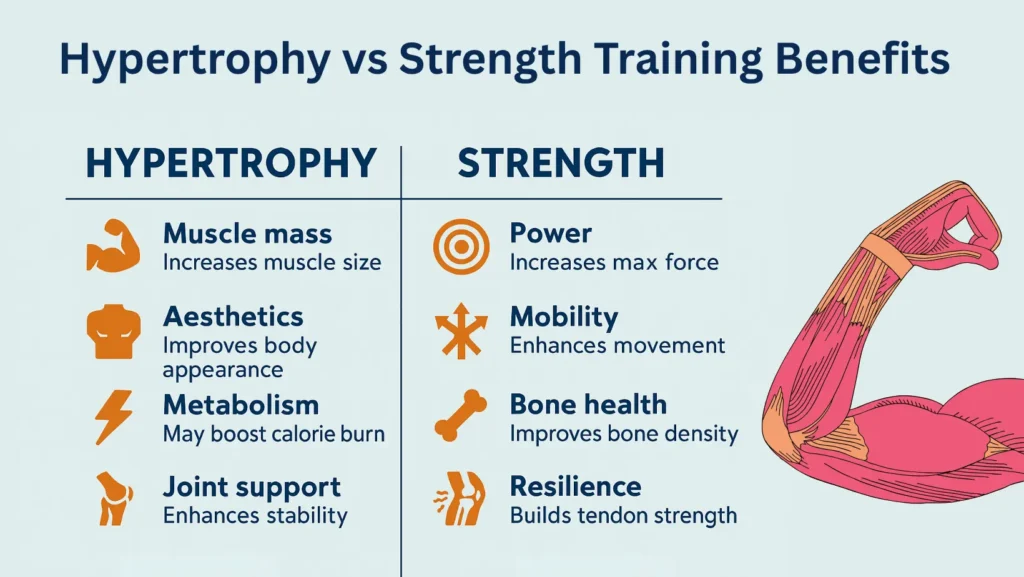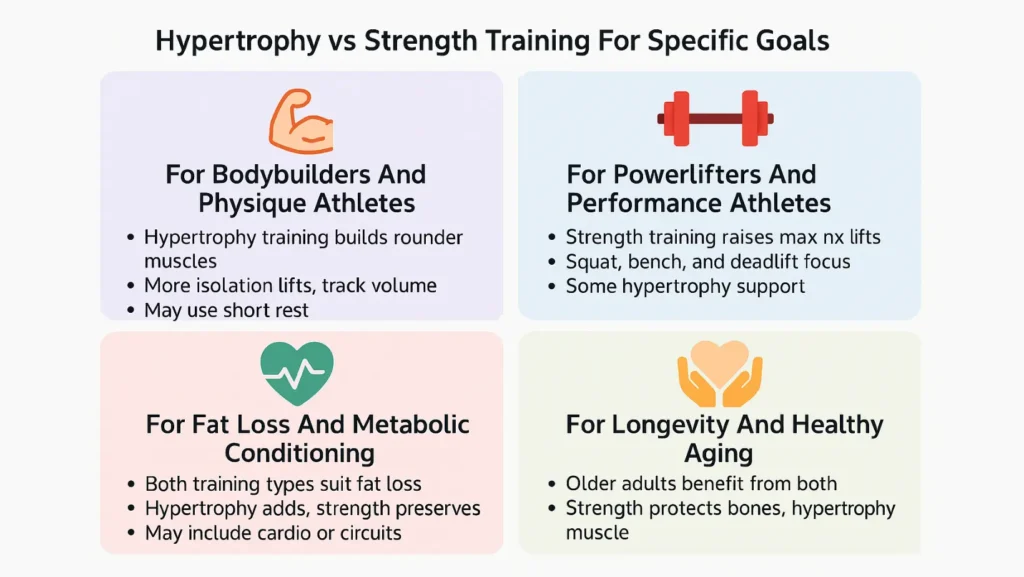Hypertrophy training grows muscle size, while strength training raises the amount of weight you can lift.
Table of Contents
ToggleYou use hypertrophy training with moderate weight, higher sets, and shorter rest to make muscles bigger. You use strength training with heavy weights, low reps, and longer rest to build raw force.
Both styles improve health, movement, and body composition when you train correctly. Choose hypertrophy training if you want bigger muscles and a fuller look. Choose strength training if you want to lift heavier and perform better in tasks or sports.
Hypertrophy Training vs Strength Training Differences
You will learn clear, practical differences between the two main lifting goals. One builds size. The other builds force. You can combine both by starting with heavy compound lifts and finishing with higher volume work.
What Is Hypertrophy Training? (Muscle Growth Focus)
Hypertrophy training targets muscle fiber size. You use moderate to high volume. You choose weights that let you do 6 to 12 reps per set. You focus on muscle tension and total work. You repeat sets to create fatigue. Muscle repair after training makes your muscles larger. You must eat enough protein and calories to support growth. Rest between sets is usually 60 to 90 seconds. You use compound and isolation exercises. You also use controlled movement speed to increase time under tension.
What Is Strength Training? (Power And Performance Focus)
Strength training trains your ability to move heavy loads. You lift heavier weights for 1 to 5 repetitions. You rest longer between sets, often 2 to 5 minutes. This gives your nervous system time to recover.
You practice big compound lifts like squat, deadlift, and bench press. Technique and bar path matter. Strength training improves how your brain and muscles work together. Nutrition and sleep still matter, but the focus stays on lifting heavier over time.
Core Differences — Goals, Volume, Intensity, And Recovery
- Goal: hypertrophy seeks size. Strength seeks maximal force.
- Volume: hypertrophy uses more sets and reps. Strength uses lower reps with higher load.
- Intensity: strength uses a higher percent of 1RM (one rep max). Hypertrophy uses a moderate percentage of 1RM.
- Recovery: You take shorter rests for hypertrophy. You take longer rests for strength.
These hypertrophy training vs strength training differences drive how you plan workouts.
Common Overlap Between The Two Training Types
You will see overlap in many programs. Both need progressive overload. Both improve muscle health and metabolism. Both reduce disease risk when combined with a good diet. You can gain some size from strength work. You can gain some strength from hypertrophy work. Smart programs use both in a planned order.
Hypertrophy vs Strength Training Benefits
Both training types give benefits that matter in daily life. Choose what fits your goals.
Benefits Of Hypertrophy Training (Aesthetic, Size, Metabolism)
Hypertrophy training grows muscle size. Larger muscles change how you look. Muscle raises resting energy use a little. This makes weight management easier. Hypertrophy improves joint support. It helps fill clothes better. For many people, this training improves confidence and posture.
Benefits Of Strength Training (Power, Mobility, Bone Health)
Strength training gives raw force. It makes you better at heavy tasks. It increases bone density. This helps prevent fractures as you age. You will gain balance and coordination. Strength work also improves tendon and joint resilience.
Shared Benefits: Endurance, Longevity, And Injury Prevention
Both styles improve movement quality over time. They help you stay active as you age. They reduce injury risk when you train with correct form. Both styles help metabolic health, blood sugar control, and mood.
Which Training Method Is Better For Fat Loss?
Both help with fat loss. Hypertrophy training increases muscle mass, which increases resting calorie use. Strength training burns calories during heavy lifts and protects muscle when you diet. For the best fat loss, combine both and use a sensible calorie plan.
Strength Training vs Hypertrophy Goals
Choose a plan that matches your main aim. Your choices must be simple and focused.
Choosing Based On Physique Vs Performance Outcomes
If you want to change your appearance, focus on hypertrophy training. Use more volume and isolation work. If you want to lift heavier or perform better in a sport, emphasize strength training. Prioritize compound lifts and low rep work.
Ideal Goals For Beginners Vs Experienced Lifters
Beginners build both size and strength quickly. Your first year gives rapid gains. Experienced lifters need targeted phases. They need planned cycles to avoid plateaus. You will need to vary load, volume, and rest as you progress.
How To Align Your Workout Plan With Your End Goal
Pick one primary goal at a time. Track simple metrics like weight lifted and body measurements. Adjust calories and protein to match your goal. Use weekly and monthly checkpoints to see progress.
Hypertrophy vs Strength Rep Range Explained
Rep ranges guide how your body adapts. Use them to match your goal.
Hypertrophy Rep Range: 6–12 Reps For Muscle Growth
The traditional size range sits between six and twelve reps. You will use this rep range in most hypertrophy sets. It gives a good balance of load and fatigue. Use 3 to 5 sets per exercise. Keep rests around 60 to 90 seconds. This range increases muscle fiber size when you add volume across the week.
Strength Training Rep Range: 1–5 Reps For Maximum Load
For maximal force, use one to five reps per set. You must lift near your 1RM. Rest more. Use fewer sets for accessories. This trains your nervous system to recruit more muscle fibers at once.
Why Tempo And Rest Time Matter More Than Reps Alone
Tempo controls muscle stress. Slow lowering increases time under tension. Faster concentric effort trains power. Rest time affects how much you can lift in the next set. Match tempo and rest to your goal to improve results.
How Progressive Overload Applies To Both Styles
You must increase your work over time. Add weight, add sets, or add reps. Track each workout. Small steady increases beat sporadic jumps. Both hypertrophy training and strength training require overload.
Hypertrophy vs Strength Workout Plan
A clear plan helps you stay on track. You must match exercises, reps, and rest with the goal you want most. This section gives you simple plans that fit both styles. These plans help you understand how a hypertrophy vs strength workout plan changes based on training needs.
Sample Hypertrophy Training Split (Push Pull Legs)
A push-pull legs split works well for hypertrophy training. You train each muscle more than once each week. You use moderate weight and higher sets.
| Push day | Pull day | Leg day |
|
|
|
You focus on good form. You stay in the 6 to 12 rep range. You use 60 to 90 seconds rest. This style supports muscle size. It also supports the hypertrophy vs strength training benefits that many people want.
Sample Strength Training Program (Compound Lifts Focus)
A strength plan focuses on fewer lifts but more load. Strength training uses lower reps. You rest longer. You build technique on each major lift.
Main lifts
- Squat
- Bench press
- Deadlift
- Overhead press
Accessory lifts
- Row
- Hamstring curl
- Core work
You use 1 to 5 reps per set. You rest 3-5 minutes. You increase the load often. This approach supports the strength training or hypertrophy goals that target force and power.
Frequency, Volume, And Rest Day Comparisons
Hypertrophy uses more total sets each week. hypertrophy training often needs 12 to 20 sets per muscle each week. You split these across 2 to 3 sessions. Strength needs fewer total sets but higher load. Strength training may use 6 to 10 sets per muscle each week, but each set is heavier.
Hypertrophy uses shorter rest. Strength uses longer rest. Hypertrophy leads to more muscle burn. Strength leads to more nervous system fatigue.
How To Combine Hypertrophy And Strength In One Program
You can mix both without hurting progress. Start with heavy sets for strength training. Then use higher volume sets for hypertrophy training. For example, begin with 3 sets of 3 on squat. Then add 3 sets of 10 on the leg press. This mix supports both size and force. It also helps you understand hypertrophy training vs strength training differences in real training.
Hypertrophy vs Strength Training For Specific Goals
Different goals need different plans. You must pick the right pattern and rep choices for your target.
For Bodybuilders And Physique Athletes
Physique work needs more detail. Hypertrophy training helps build rounder muscles. You use more isolation lifts. You track volume. You watch recovery and nutrition. You may use a short rest to create more muscle stress. This helps shape each muscle group.
For Powerlifters And Performance Athletes
Powerlifters use strength training to raise their max lifts. They train squat, bench, and deadlift with heavy loads. They repeat movement patterns often. They rest longer. They plan peak blocks before events. They include small parts of hypertrophy as support.
For Fat Loss And Metabolic Conditioning
You can use both hypertrophy and strength for fat loss. Hypertrophy training adds muscle mass. This helps you burn more calories each day. Strength training protects muscle when you eat fewer calories. You can mix short cardio or circuit work between sets. Fat loss depends on food intake, not only exercise.
For Longevity And Healthy Aging
Older adults benefit from both. Strength training helps keep bones strong. Hypertrophy training helps preserve muscle. This lowers fall risk and improves daily tasks. You use safe loads and good form. You do not need heavy weights to start.
Training Variables That Separate Hypertrophy From Strength
Training variables help you adjust your plan. You can change one variable at a time to match your goal.
Load Intensity And Percentage Of 1RM
Hypertrophy uses about 60 to 80 percent of 1RM. You can keep tension high for many reps. Strength uses 85 percent or more. These loads teach your nervous system to use more muscle fibers. Both hypertrophy training and strength training depend on correct load choices.
Rest Intervals: Short Vs Long Recovery Periods
Hypertrophy uses short rest. This increases muscle stress. Strength uses long rest. This helps you lift heavier in the next set. Your rest length affects your progress.
Training Frequency And Muscle Fatigue Patterns
Training frequency means how many times you train each muscle each week. Hypertrophy uses more frequency with moderate loads. Strength uses fewer sessions with heavy loads. Both styles create fatigue in a different way. You must schedule rest days.
Time Under Tension And Neuromuscular Activation
Time under tension affects muscle growth. You control each rep so the muscle stays active. Strength focuses more on neuromuscular activation. This means your brain sends faster and stronger signals to your muscles. Both support results, but in different ways.
Common Mistakes In Hypertrophy And Strength Training
You avoid mistakes by watching your form, load, and rest. These mistakes stop progress if ignored.
Lifting Too Heavy Or Too Light For The Goal
Some people lift too heavy during hypertrophy training and lose form. Others lift too light during strength training and fail to improve force. Match the load to your rep range and goal.
Ignoring Rest And Recovery Windows
Sleep, rest days, and protein affect results. Overwork without rest slows progress in both styles. Your muscles repair during rest, not during training.
Poor Nutrition For Muscle Repair And Growth
You need protein for repair. You need calories for size. You need carbs for energy. Without correct food, both strength training and hypertrophy training slow down.
Overtraining Without Deload Phases
Your body cannot push hard every week. You need lighter weeks. These deload weeks lower fatigue. They help you avoid injury. They improve long-term results.
FAQs
Can I Build Muscle While Doing Strength Training?
Yes. Strength training can build muscle when you add higher rep accessory sets. This helps muscle size improve while you still work on power.
Is Hypertrophy Better For Aesthetics And Muscle Tone?
Yes. Hypertrophy training grows muscle fibers. This supports fuller shape, more detail, and better tone when body fat drops to a healthy level.
Which Burns More Calories, Hypertrophy Or Strength Training?
Both burn calories. hypertrophy training adds lean mass, which raises daily calorie burn. Strength training uses heavy lifts that burn energy during each session.
How Often Should I Train For Hypertrophy Vs Strength?
Hypertrophy works best at two to three sessions per muscle each week. Strength needs two to four heavy sessions for main lifts. Both improve with steady plans.
Can I Combine Hypertrophy And Strength In One Session?
Yes. Start with strength training for heavy sets. Add hypertrophy training after with higher reps and volume. This supports both size and force.
What Is The Ideal Hypertrophy vs Strength Rep Range?
Hypertrophy uses six to twelve reps. Strength uses one to five reps. These rep patterns support the hypertrophy vs strength rep range used in many plans.
Does Hypertrophy Training Make You Stronger?
Yes. Hypertrophy training adds muscle mass, which helps you lift more. This also supports long-term strength gains when you shift to lower rep training.
Is Strength Training Only For Powerlifters?
No. Strength training helps everyone. It improves daily tasks, bone health, and movement at all ages. It is not limited to athletes.
Can Women Train For Both Hypertrophy And Strength?
Yes. Women respond well to both. Hypertrophy training builds muscle shape. Strength training builds force. Women can use both with great results.
Which Type Is Better For Fat Loss And Toning?
Both help fat loss when paired with a calorie plan. Hypertrophy training increases muscle mass. Strength training preserves muscle and supports heavy lifts.
How Long Does It Take To See Results From Hypertrophy Vs. Strength Training?
Most people see changes in six to twelve weeks. Hypertrophy training shows size changes. Strength training shows faster progress in load numbers.
Do Hypertrophy Workouts Cause Muscle Soreness More Often?
Yes. Hypertrophy training uses more volume. This can cause more soreness until your body adapts. Soreness is not required for growth.

This article is medically reviewed by Dr. Chandril Chugh, Board-Certified Neurologist, providing expert insights and reliable health information.
Dr. Chandril Chugh is a U.S.-trained neurologist with over a decade of experience. Known for his compassionate care, he specializes in treating neurological conditions such as migraines, epilepsy, and Parkinson’s disease. Dr. Chugh is highly regarded for his patient-centered approach and dedication to providing personalized care.










